Suppression Mechanisms of Stratified Jet-in-Crossflow on Thermoacoustic Instability and NOx Emissions in Premixed Combustors
Abstract
1. Introduction
2. Experimental Setup
2.1. Combustion Test Bench and Instruments
2.2. Method and Materials
3. Results and Discussions
3.1. Suppression of Thermoacoustic Instability
3.2. Transition of Thermoacoustic Instability Modes
3.3. Suppression of NOx Emissions
4. Conclusions
Author Contributions
Funding
Institutional Review Board Statement
Informed Consent Statement
Data Availability Statement
Conflicts of Interest
References
- Morgans, A.; Yang, D. Thermoacoustic instability in combustors. Annu. Rev. Fluid Mech. 2024, 57, 9–33. [Google Scholar] [CrossRef]
- Liu, C.; Yang, H.; Ruan, C.; Yu, L.; Lu, X. Influence of swirl intensity on combustion dynamics and emissions in an ammonia-enriched methane/air combustor. Phys. Fluids 2024, 36, 034123. [Google Scholar] [CrossRef]
- Wang, Z.; Lin, W.; Tong, Y.; Guo, K.; Chen, P.; Nie, W.; Huang, W. Early detection of thermoacoustic instability in an O2/CH4 single-injector rocket combustor using analysis of chaos and deep learning models. Phys. Fluids 2024, 36, 034101. [Google Scholar] [CrossRef]
- Han, X.; Chang, Y.; Wang, Z.; Zhang, C.; Tao, W.; Lin, Y. Experimental study on spray ignition and blow out performances in a centrally staged annular combustor: Low pressure conditions. Phys. Fluids 2024, 36, 107129. [Google Scholar] [CrossRef]
- Yin, B.; Yang, Z.; Guan, Y.; Redonnet, S.; Gupta, V.; Li, L.K.B. Genetic programing control of self-excited thermoacoustic oscillations. Phys. Fluids 2024, 36, 064102. [Google Scholar] [CrossRef]
- Alhazmi, K.; Sarathy, S. Adaptive phase shift control of thermoacoustic combustion instabilities using model-free reinforcement learning. Combust. Flame 2023, 257, 113040. [Google Scholar] [CrossRef]
- Zhao, D.; Lu, Z.; Zhao, H.; Li, X.; Wang, B.; Liu, P. A review of active control approaches in stabilizing combustion systems in aerospace industry. Prog. Aerosp. Sci. 2018, 97, 35–60. [Google Scholar] [CrossRef]
- Zhao, D.; Li, X. A review of acoustic dampers applied to combustion chambers in aerospace industry. Prog. Aerosp. Sci. 2015, 74, 114–130. [Google Scholar] [CrossRef]
- Wang, P.; Tian, Y.; Yang, L.; Luo, S.; Li, J.; Liu, T. Open-loop control of thermoacoustic instabilities by the external acoustic forcing at different frequencies. Proc. Combust. Inst. 2024, 40, 105540. [Google Scholar] [CrossRef]
- Miniero, L.; Mensah, G.; Bourquard, C.; Noiray, N. Failure of thermoacoustic instability control due to periodic hot gas ingestion in Helmholtz dampers. J. Sound Vib. 2024, 548, 117544. [Google Scholar] [CrossRef]
- Jin, U.; Kim, K.T. Influence of radial fuel staging on combustion instabilities and exhaust emissions from lean-premixed multi-element hydrogen/methane/air flames. Combust. Flame 2022, 242, 112184. [Google Scholar] [CrossRef]
- Wei, D.; Li, H.; Fang, H.; Zhou, H.; Li, H.; Liu, H.; Hu, X.; Zhang, H. Analysis of thermoacoustic instability and emission behaviors of lean premixed biogas/ammonia flame. J. Energy Inst. 2025, 118, 101923. [Google Scholar] [CrossRef]
- Altay, H.; Hudgins, D.; Speth, R.; Annaswamy, A.; Ghoniem, A. Mitigation of thermoacoustic instability utilizing steady air injection near the flame anchoring zone. Combust. Flame 2010, 157, 686–700. [Google Scholar] [CrossRef]
- Cao, W.; Yang, K.; Ren, Y.; Guo, K.; Tong, Y.; Huang, W.; Nie, W. Experimental studies on suppressing thermoacoustic oscillations by secondary gas injection in a premixed swirl combustor. Phys. Fluids 2024, 36, 085145. [Google Scholar] [CrossRef]
- Zhou, H.; Tao, C. Effects of annular N2/O2 and CO2/O2 jets on combustion instabilities and NOx emissions in lean-premixed methane flames. Fuel 2020, 263, 116709. [Google Scholar] [CrossRef]
- Hu, L.; Zhou, H. Experimental investigation of combustion instability and NOx emissions control by adjustable swirl jet in lean premixed flames. J. Energy Inst. 2023, 106, 10114. [Google Scholar] [CrossRef]
- Liu, Z.; Wei, D.; Ji, M.; Fang, H.; Zhou, H. Combustion instability of ethanol and n-heptane fuels under different combustor geometries. J. Energy Inst. 2022, 102, 206–215. [Google Scholar] [CrossRef]
- Oztarlik, G.; Selle, L.; Poinsot, T.; Schuller, T. Suppression of instabilities of swirled premixed flames with minimal secondary hydrogen injection. Combust. Flame 2020, 214, 266–276. [Google Scholar] [CrossRef]
- Barbosa, S.; Garcia, M.; Ducruix, S.; Labegorre, B.; Lacas, F. Control of combustion instabilities by local injection of hydrogen. Proc. Combust. Inst. 2007, 31, 3207–3214. [Google Scholar] [CrossRef]
- Balasubramanian, N.; Cao, D.; Greenberg, I.; Michaels, D. Mitigation of combustion instabilities by local diluent injection in a premixed swirl stabilized combustor. Combust. Flame 2020, 245, 112334. [Google Scholar] [CrossRef]
- Labry, Z.; Shanbhogue, S.; Speth, R.; Ghoniem, A. Flow structures in a lean-premixed swirl-stabilized combustor with microjet air injection. Proc. Combust. Inst. 2011, 33, 1575–1581. [Google Scholar] [CrossRef]
- Cao, D.; Greenberg, I.; Balasubramanian, N.; Brod, H.; Michaels, D. The impact of N2 micro-jets on the V-to-M flame shape transition in a premixed swirl burner. Proc. Combust. Inst. 2023, 39, 5021–5031. [Google Scholar] [CrossRef]
- Fang, H.; Wei, D.; Hu, L.; Zhou, H. Combustion instability and emission characteristics of spray flame under flue gas jet. Fuel 2024, 358, 130281. [Google Scholar] [CrossRef]
- Li, F.; Du, M.; Yang, L. Effect of fuel injection parameters on performance characteristics and emissions of a thermoacoustic system. Aerosp. Sci. Technol. 2021, 110, 106512. [Google Scholar] [CrossRef]
- Tao, C.; Zhou, H. Effects of superheated steam on combustion instability and NOx emissions in a model lean premixed gas turbine combustor. Fuel 2021, 288, 119646. [Google Scholar] [CrossRef]
- Tao, C.; Zhou, Z. Effects of different preheated CO2/O2 jet in cross-flow on combustion instability and emissions in a lean-premixed combustor. J. Energy Inst. 2020, 93, 101149. [Google Scholar] [CrossRef]
- Omi, K.; Nakayama, K.; Hirose, K.; Takizawa, K.; Taguchi, H.; Nakaya, S.; Tsue, M. Nonlinear mode decomposition of combustion instabilities under various jet-to-crossflow momentum ratios in a hydrogen-rich ram combustor using a deep Koopman network. Combust. Flame 2024, 268, 113643. [Google Scholar] [CrossRef]
- Khalil, A.; Gupta, A. Flame fluctuations in Oxy-CO2-methane mixtures in swirl assisted distributed combustion. Appl. Energy 2017, 204, 303–317. [Google Scholar] [CrossRef]
- Choi, Y.; Kim, K. Mode shape-dependent thermoacoustic interactions between a lean-premixed primary flame and an axially-staged transverse reacting jet. Combust. Flame 2023, 255, 112884. [Google Scholar] [CrossRef]
- Xu, G.; Wang, B.; Jin, B.; Wang, Z.; Liu, P. Numerical study of triggered thermoacoustic instability driven by linear and nonlinear combustion response in a solid rocket motor. Phys. Fluids 2024, 36, 034110. [Google Scholar] [CrossRef]
- Liu, J.; Pang, B.; Wang, T.; Yang, L.; Li, J. Investigation of the buoyancy effect on the thermoacoustic instability in an electrically heated Rijke tube. Phys. Fluids 2024, 36, 054119. [Google Scholar] [CrossRef]
- Shelton, C.M.; Majdalani, J. Thermoacoustic velocity and pressure oscillations in one-dimensional combustors with spatially varying heat sources and thermal distributions. Phys. Fluids 2024, 36, 044106. [Google Scholar] [CrossRef]
- Signor, E.T.; Shelton, C.M.; Majdalani, J. Characterization of the acoustic pressure waveforms in Rijke tubes with spatially varying heat sources and temperature distributions. Phys. Fluids 2024, 36, 034113. [Google Scholar] [CrossRef]
- Tao, C.; Wang, Y.; Zhou, H. Synchronous suppression of combustion instabilities and NOx emissions with O2/N2/CO2 ternary gases jetting into the unsteady lean-premixed flame. Fuel 2025, 384, 134037. [Google Scholar] [CrossRef]
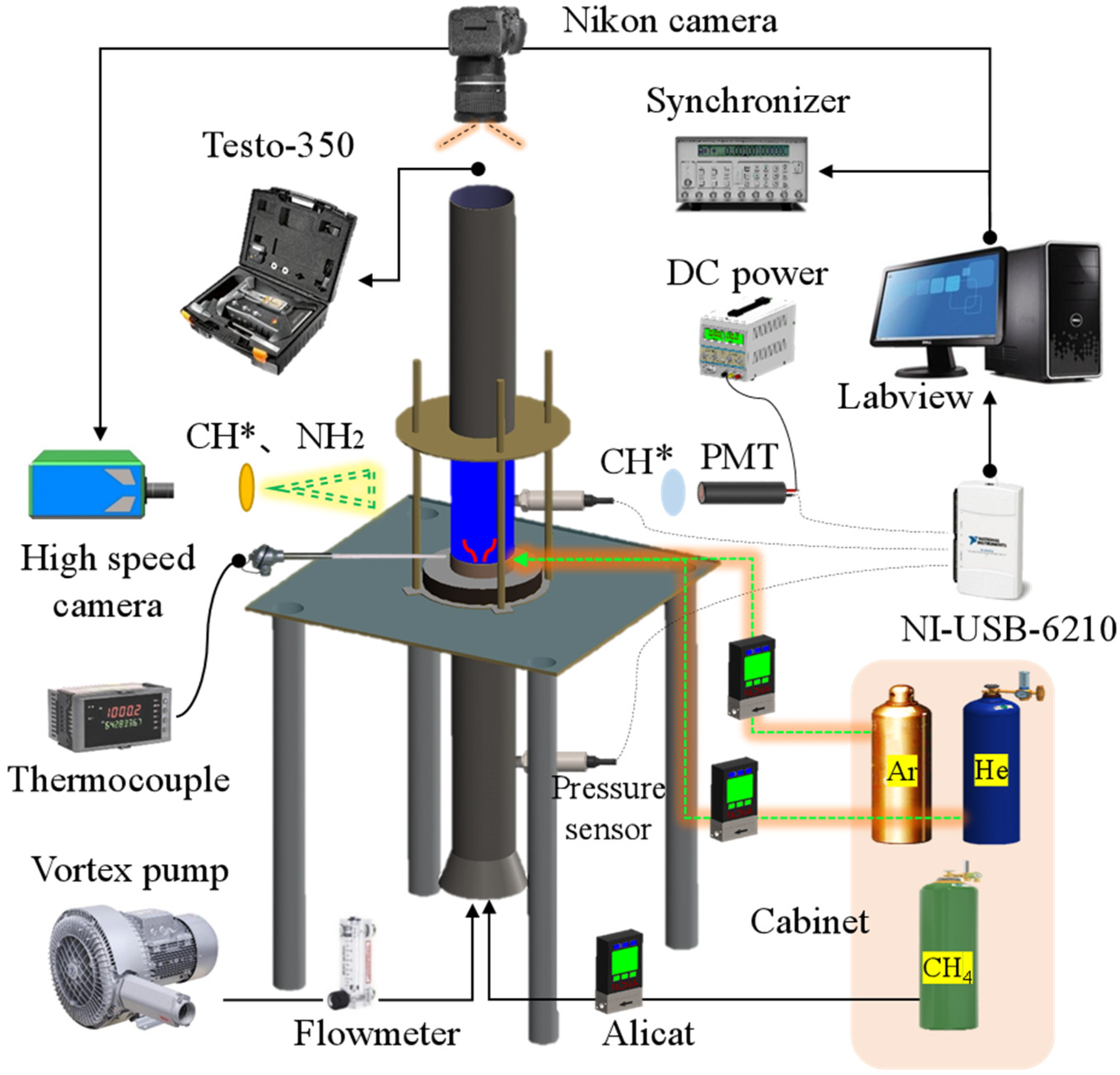
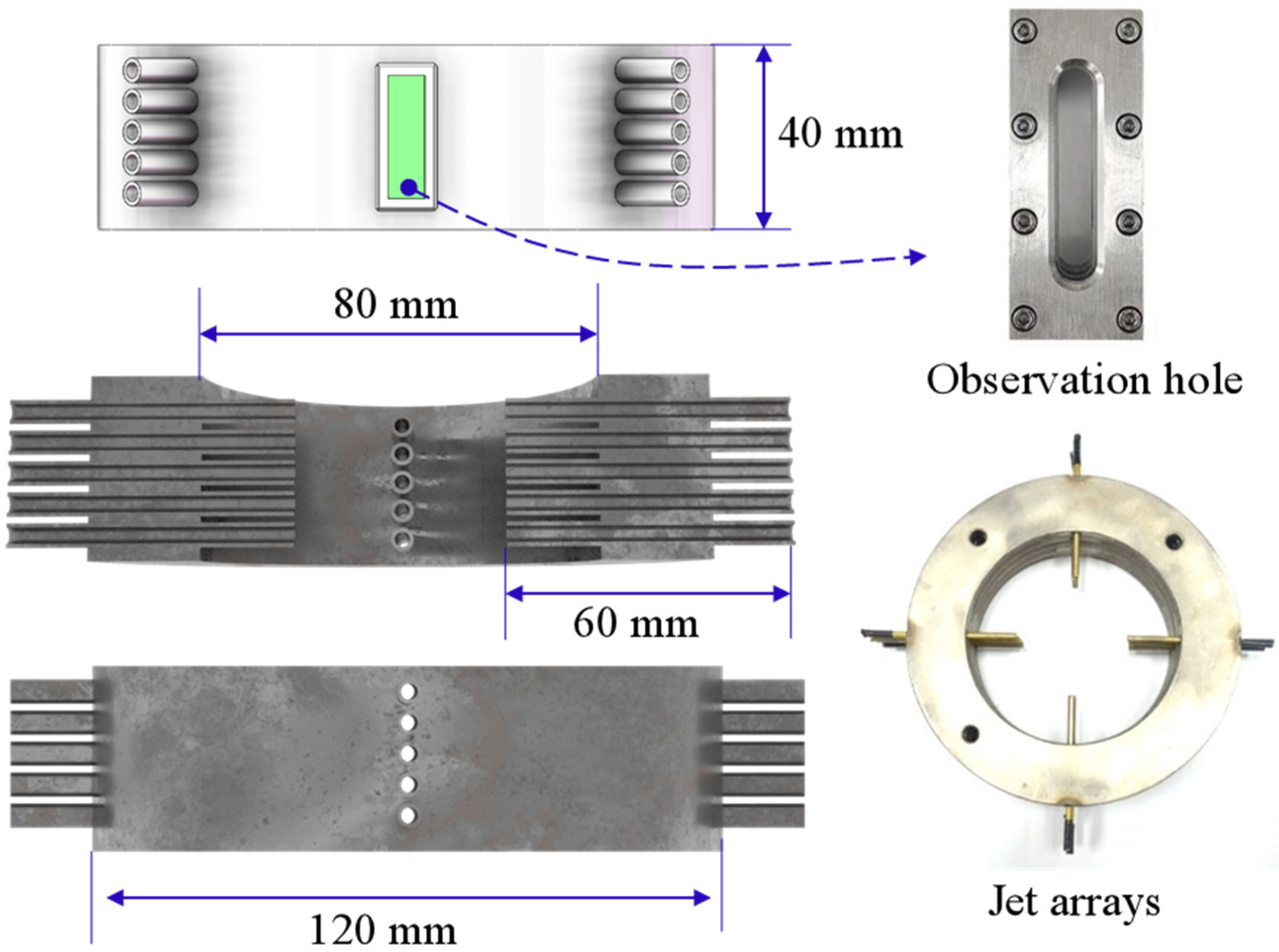
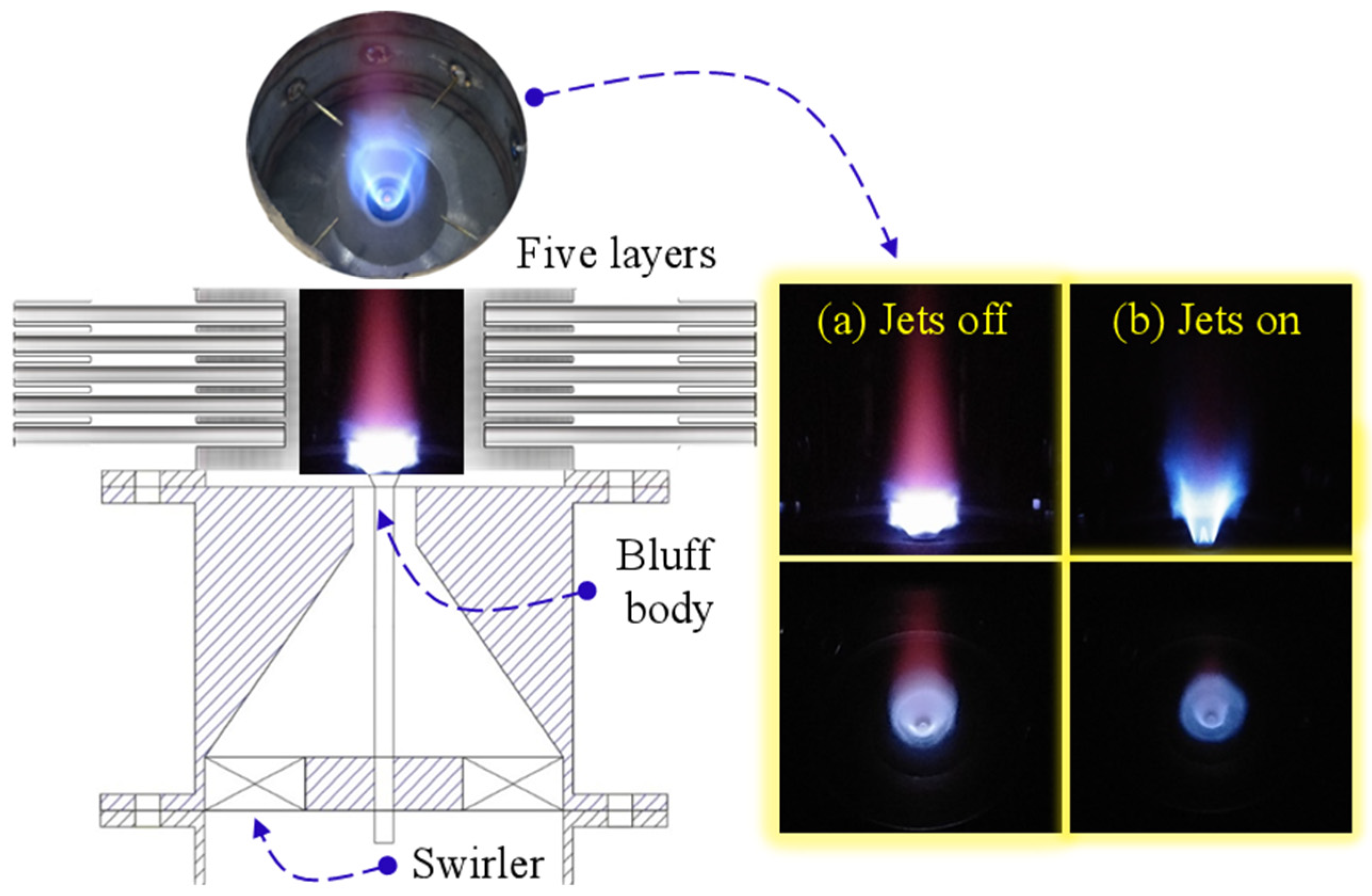

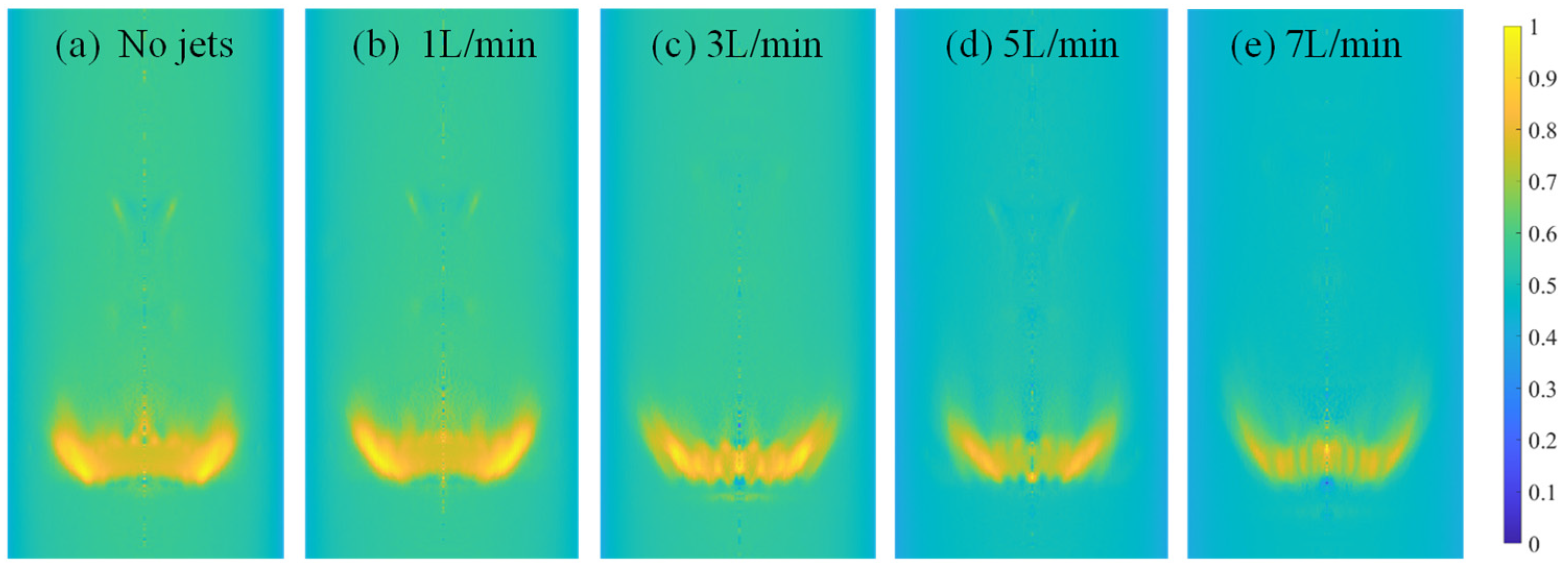

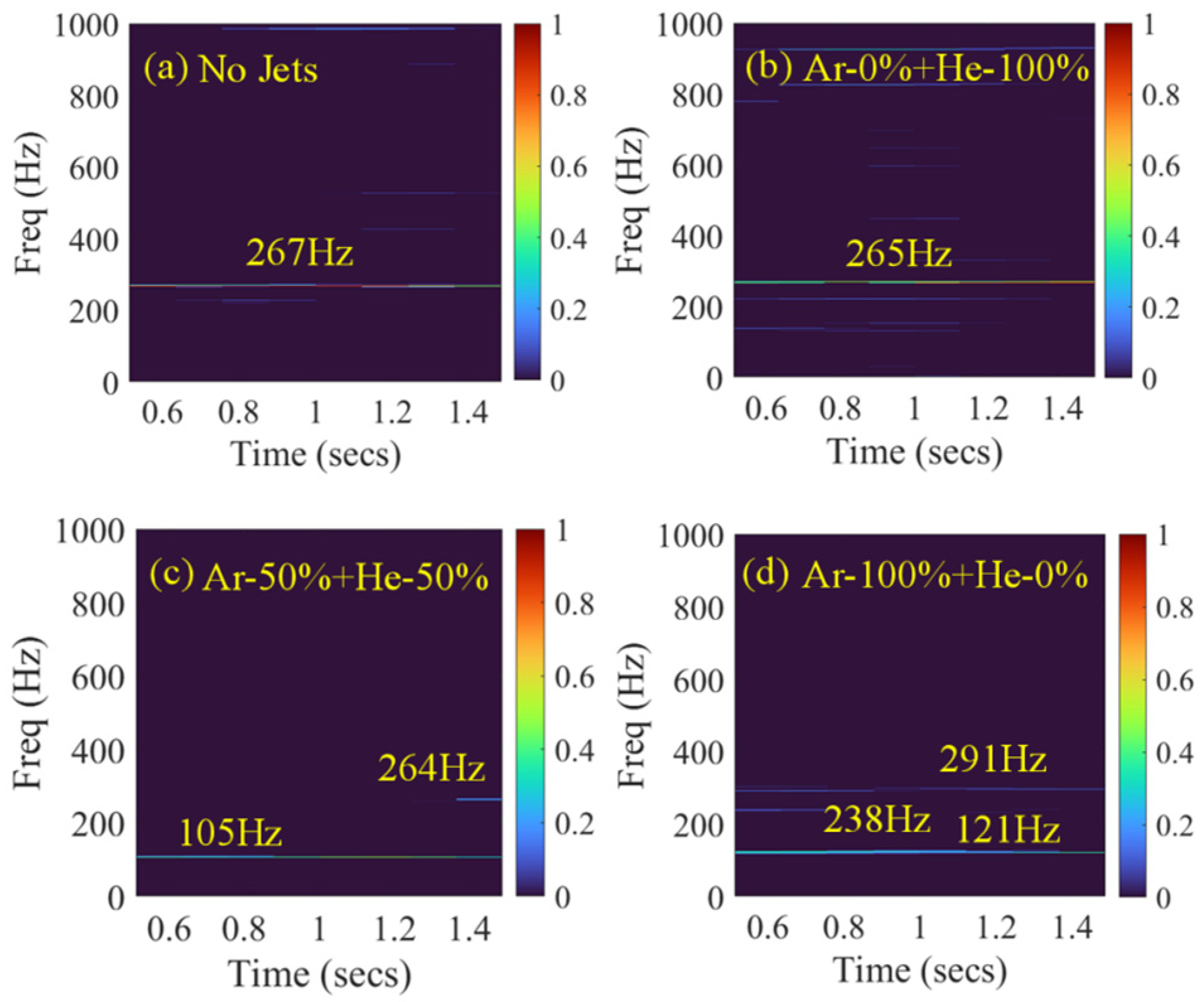
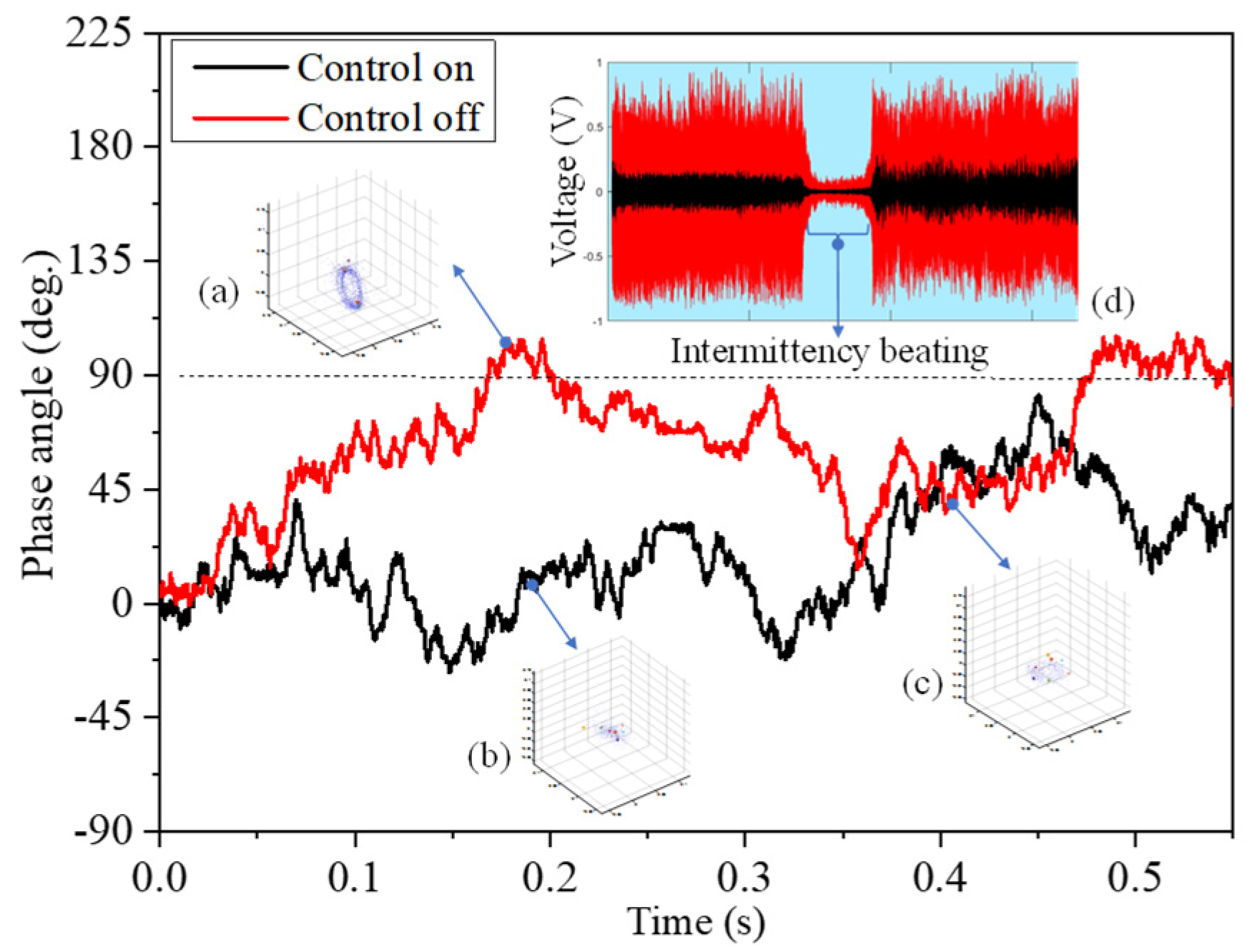
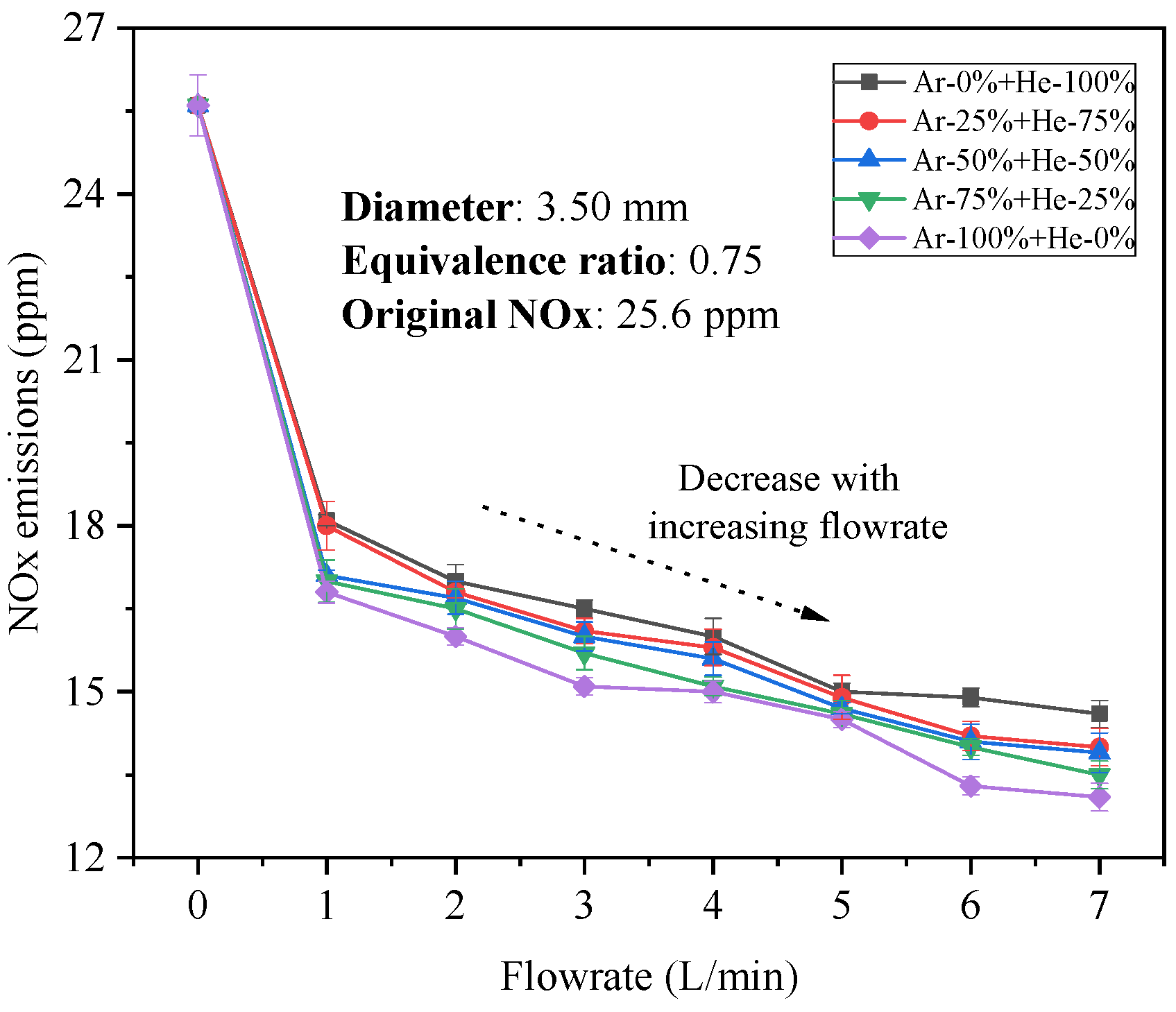


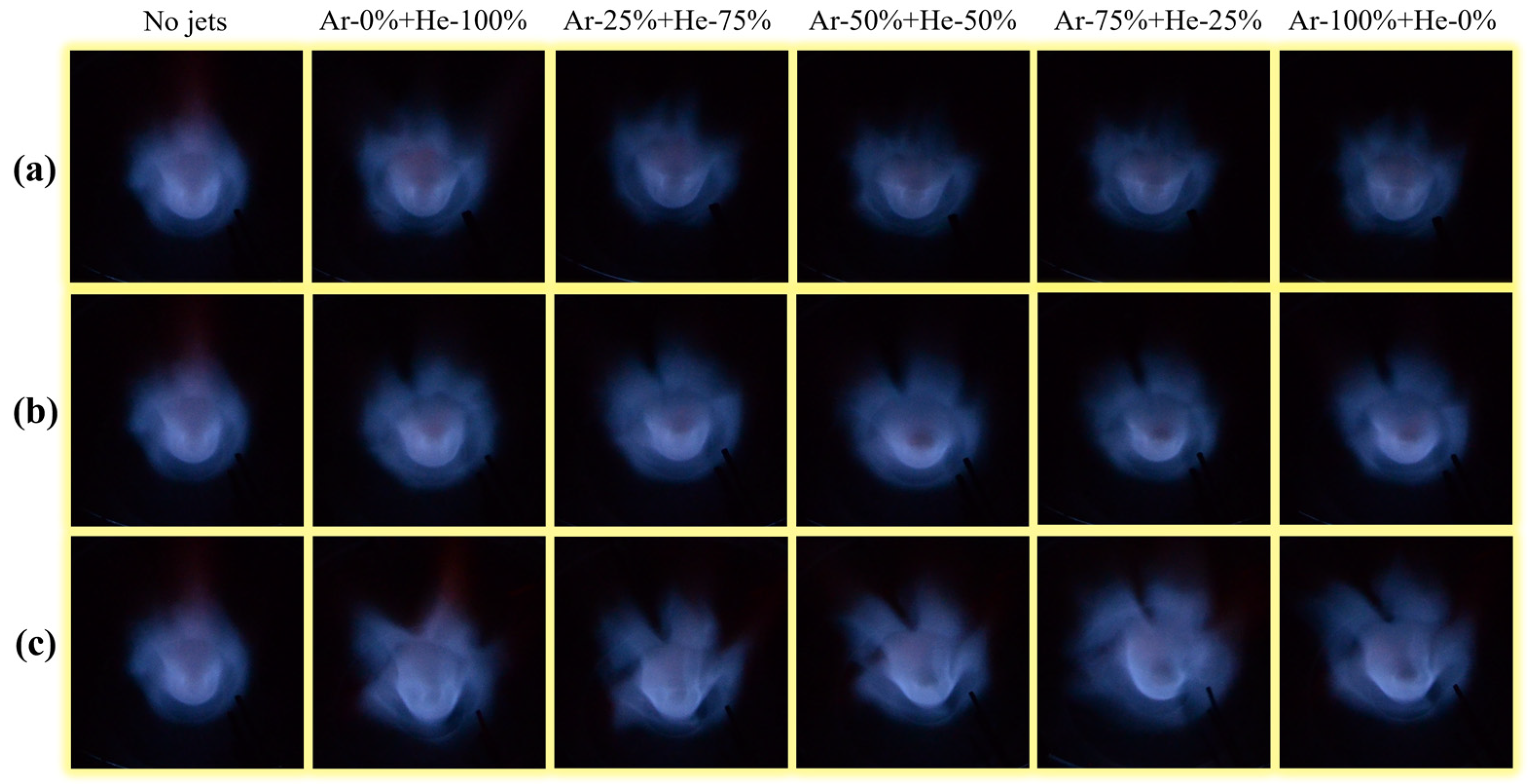

| Parameters | Units | Values |
|---|---|---|
| Thermal power | kW | 4.0 |
| Equivalence ratio | / | 0.75 |
| Self-excited frequency | Hz | 267 |
| Self-excited amplitude | Pa | 25.18 |
| Jets flow rate | L/min | 1.0–7.0 |
| Injection hole diameter | Mm | 2.00–3.50 |
| Gas densities | kg/m3 | 1.784, 1.383, 0.982, 0.581, and 0.18 |
Disclaimer/Publisher’s Note: The statements, opinions and data contained in all publications are solely those of the individual author(s) and contributor(s) and not of MDPI and/or the editor(s). MDPI and/or the editor(s) disclaim responsibility for any injury to people or property resulting from any ideas, methods, instructions or products referred to in the content. |
© 2025 by the authors. Licensee MDPI, Basel, Switzerland. This article is an open access article distributed under the terms and conditions of the Creative Commons Attribution (CC BY) license (https://creativecommons.org/licenses/by/4.0/).
Share and Cite
Sun, R.; Tao, C. Suppression Mechanisms of Stratified Jet-in-Crossflow on Thermoacoustic Instability and NOx Emissions in Premixed Combustors. Appl. Sci. 2025, 15, 2819. https://doi.org/10.3390/app15052819
Sun R, Tao C. Suppression Mechanisms of Stratified Jet-in-Crossflow on Thermoacoustic Instability and NOx Emissions in Premixed Combustors. Applied Sciences. 2025; 15(5):2819. https://doi.org/10.3390/app15052819
Chicago/Turabian StyleSun, Rongyue, and Chengfei Tao. 2025. "Suppression Mechanisms of Stratified Jet-in-Crossflow on Thermoacoustic Instability and NOx Emissions in Premixed Combustors" Applied Sciences 15, no. 5: 2819. https://doi.org/10.3390/app15052819
APA StyleSun, R., & Tao, C. (2025). Suppression Mechanisms of Stratified Jet-in-Crossflow on Thermoacoustic Instability and NOx Emissions in Premixed Combustors. Applied Sciences, 15(5), 2819. https://doi.org/10.3390/app15052819





